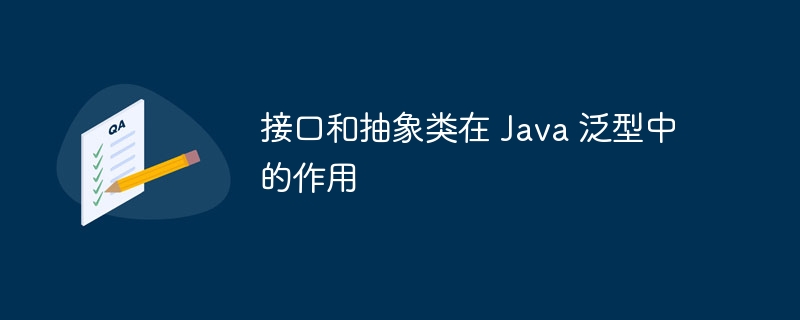The role of interfaces and abstract classes in Java generics
Interface is used to define the behavior that a class must implement, allowing subtyping. Abstract classes contain abstract methods, allowing polymorphism. Abstract classes cannot be instantiated.

The role of interfaces and abstract classes in Java generics
Introduction
Generics Is a powerful programming technique that allows us to create reusable code without specifying specific types. Interfaces and abstract classes play a crucial role in generics, providing mechanisms to achieve polymorphism and abstraction in typed systems.
Interface
An interface is an abstract type that only contains method declarations. It defines a set of methods that must be implemented by any class that implements the interface. An interface cannot contain any fields or constructors.
Subtyping
The interface can be used to establish subtyping relationships. When a class implements an interface, it becomes a subtype of that interface. This means that an object of that class can be assigned to that interface type variable, just like a child class object can be assigned to its parent class type variable.
Practical example
public interface Comparable<T> {
int compareTo(T other);
}
public class Person implements Comparable<Person> {
private String name;
private int age;
@Override
public int compareTo(Person other) {
return this.age - other.age;
}
}
// 使用示例
List<Person> people = new ArrayList<>();
people.add(new Person("John", 30));
people.add(new Person("Mary", 25));
Collections.sort(people); // 使用接口实现按年龄排序In this example, the Person class implements the Comparable interface so that it can be sorted by age Compare. This means we can sort a collection of Person objects using the Collections.sort() method.
Abstract class
An abstract class is a class that cannot be instantiated. It can contain abstract methods (methods without implementation), as well as ordinary methods and fields.
Polymorphism
Abstract classes allow objects to be used in a polymorphic manner. When you create a variable that refers to an abstract class type, it can refer to an object of that class or any of its subclasses.
Practical example
public abstract class Shape {
private String color;
public abstract double getArea();
}
public class Rectangle extends Shape {
private double width;
private double height;
@Override
public double getArea() {
return width * height;
}
}
public class Circle extends Shape {
private double radius;
@Override
public double getArea() {
return Math.PI * radius * radius;
}
}
// 使用示例
List<Shape> shapes = new ArrayList<>();
shapes.add(new Rectangle(5, 10));
shapes.add(new Circle(5));
for (Shape shape : shapes) {
System.out.println(shape.getArea());
}In this example, Shape is an abstract class that defines a getArea() Method implemented by its subclasses Rectangle and Circle. This allows us to create objects of various shapes and store them in a collection and use them in a polymorphic way.
The above is the detailed content of The role of interfaces and abstract classes in Java generics. For more information, please follow other related articles on the PHP Chinese website!

Hot AI Tools

Undresser.AI Undress
AI-powered app for creating realistic nude photos

AI Clothes Remover
Online AI tool for removing clothes from photos.

Undress AI Tool
Undress images for free

Clothoff.io
AI clothes remover

AI Hentai Generator
Generate AI Hentai for free.

Hot Article

Hot Tools

Notepad++7.3.1
Easy-to-use and free code editor

SublimeText3 Chinese version
Chinese version, very easy to use

Zend Studio 13.0.1
Powerful PHP integrated development environment

Dreamweaver CS6
Visual web development tools

SublimeText3 Mac version
God-level code editing software (SublimeText3)

Hot Topics
 Square Root in Java
Aug 30, 2024 pm 04:26 PM
Square Root in Java
Aug 30, 2024 pm 04:26 PM
Guide to Square Root in Java. Here we discuss how Square Root works in Java with example and its code implementation respectively.
 Perfect Number in Java
Aug 30, 2024 pm 04:28 PM
Perfect Number in Java
Aug 30, 2024 pm 04:28 PM
Guide to Perfect Number in Java. Here we discuss the Definition, How to check Perfect number in Java?, examples with code implementation.
 Random Number Generator in Java
Aug 30, 2024 pm 04:27 PM
Random Number Generator in Java
Aug 30, 2024 pm 04:27 PM
Guide to Random Number Generator in Java. Here we discuss Functions in Java with examples and two different Generators with ther examples.
 Armstrong Number in Java
Aug 30, 2024 pm 04:26 PM
Armstrong Number in Java
Aug 30, 2024 pm 04:26 PM
Guide to the Armstrong Number in Java. Here we discuss an introduction to Armstrong's number in java along with some of the code.
 Weka in Java
Aug 30, 2024 pm 04:28 PM
Weka in Java
Aug 30, 2024 pm 04:28 PM
Guide to Weka in Java. Here we discuss the Introduction, how to use weka java, the type of platform, and advantages with examples.
 Smith Number in Java
Aug 30, 2024 pm 04:28 PM
Smith Number in Java
Aug 30, 2024 pm 04:28 PM
Guide to Smith Number in Java. Here we discuss the Definition, How to check smith number in Java? example with code implementation.
 Java Spring Interview Questions
Aug 30, 2024 pm 04:29 PM
Java Spring Interview Questions
Aug 30, 2024 pm 04:29 PM
In this article, we have kept the most asked Java Spring Interview Questions with their detailed answers. So that you can crack the interview.
 Break or return from Java 8 stream forEach?
Feb 07, 2025 pm 12:09 PM
Break or return from Java 8 stream forEach?
Feb 07, 2025 pm 12:09 PM
Java 8 introduces the Stream API, providing a powerful and expressive way to process data collections. However, a common question when using Stream is: How to break or return from a forEach operation? Traditional loops allow for early interruption or return, but Stream's forEach method does not directly support this method. This article will explain the reasons and explore alternative methods for implementing premature termination in Stream processing systems. Further reading: Java Stream API improvements Understand Stream forEach The forEach method is a terminal operation that performs one operation on each element in the Stream. Its design intention is






